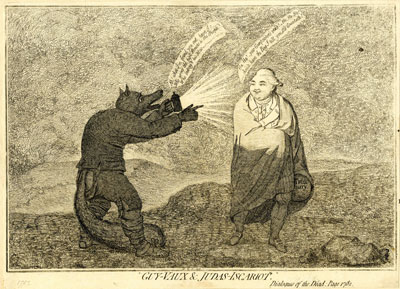Guy Vaux & Judas Iscariot
The subtitle of this print is Dialogues of the Dead, Page 1782. The reference is to a series of fictitious dialogues between historical and/or mythological figures created by the Greek writer/rhetorician, Lucian for satiric purposes. Some of the interlocutors included Philip and Alexander, Pluto and Hermes, Ajax and Agamemnon. The satiric dialogue structure was then imitated and updated by later writers in both France and England including Dialogues of the Dead by George, Lord Lyttelton in 1760 with new dialogues between Joseph Addison and Jonathan Swift, Fernando Cortez and William Penn, and Boileau and Alexander Pope. .

© Trustees of the British Museum
The supposed "dead" conversationalists in this case are the infamous conspirator Guy Fawkes, one of the masterminds of the Gunpowder Plot who, in 1605, tried to assassinate King James and blow up the House of Lords; and the equally despicable Judas Iscariot, who betrayed his master, Jesus Christ, to the Sanhedrin for 30 pieces of silver.
But, of course, the satiric thrust of the dialogue is not at the historical Guy and Judas, but the two men they represent in "1782" when a new "page" had been turned with the unexpected death of Prime Minister Charles Watson-Wentworth, Marquess of Rockingham. Both Charles James Fox (Fawkes) and the Earl of Shelburne (Judas) had been part of the Rockingham ministry: Fox as Secretary of State for Foreign Affairs and Shelburne as Secretary of State for the Home Department. Both deeply distrusted one another and harbored very different plans for Rockingham's successor as First Lord of the Treasury and Prime Minister. So when Shelburne was, in fact, chosen by the King to lead the new ministry, Fox resigned. He argued (disingenuously) as Fox/Fawkes does here that Shelburne was a betrayer (like Judas) of his master (Rockingham), that the "true" successors of Rockingham's principles were the Portland Whigs, nominally led by the Duke of Portland, but, in reality, driven by (you guessed it) Fox. Convinced that others in the former Rockingham administration would buy his arguments and resign with him, Fox's intent was (like Guy Fawkes) to "blow up" the Shelburne ministry before it had scarcely begun. It was the worst miscalculation of his career.
A few friends and associates, Edmund Burke for one, resigned with Fox. But most people, like the gloating Shelburne/Judas in the print, saw it as a toothless and unsuccessful fit of pique at not getting his preferred candidate at Treasury.
Ha! Ha! – poor Gunpowder's vexed! – He, He, He! – Shan't have the Bag [labeled Treasury] I tell you, Old Goosetooth!
Worst of all, the King saw it as a dereliction of duty, and would resolutely refuse to consider Fox for a position in government for almost the next twenty five years.
Though not the best known of Gillray's prints, Guy Vaux & Judas Iscariot is a brilliant example of Gillray's skill as a parodist of other art forms and as a satirist simultaneously using the frames of popular English history and the Biblical New Testament to draw relevant parallels to the current political situation.
Sources and Reading
- Commentary from the British Museum on Guy Vaux & Judas Iscariot.
- "Guy Fawkes," Wikipedia
- "Judas Iscariot," Wikipedia
- "Charles James Fox," Wikipedia
- "William Petty, 2nd Earl of Shelburne," Wikipedia
- "Lucian," Wikipedia
- "Lucian, Dialogues of the Dead" Wikipedia
- "Dialogues of the Dead by Lord Lyttelton" Wikipedia
- Thomas Wright and Joseph Grego, The Works of James Gillray, the Caricaturist; With the History of His Life and Times, p. 41.
Comments & Corrections
NOTE: Comments and/or corrections are always appreciated. To make that easier, I have included a form below that you can use. I promise never to share any of the info provided without your express permission.